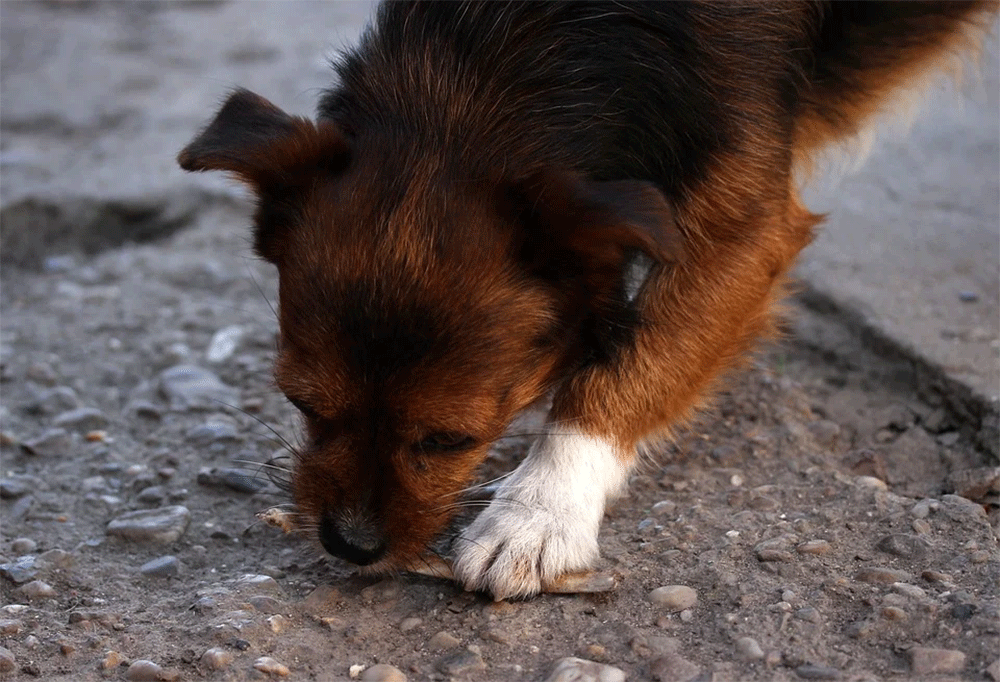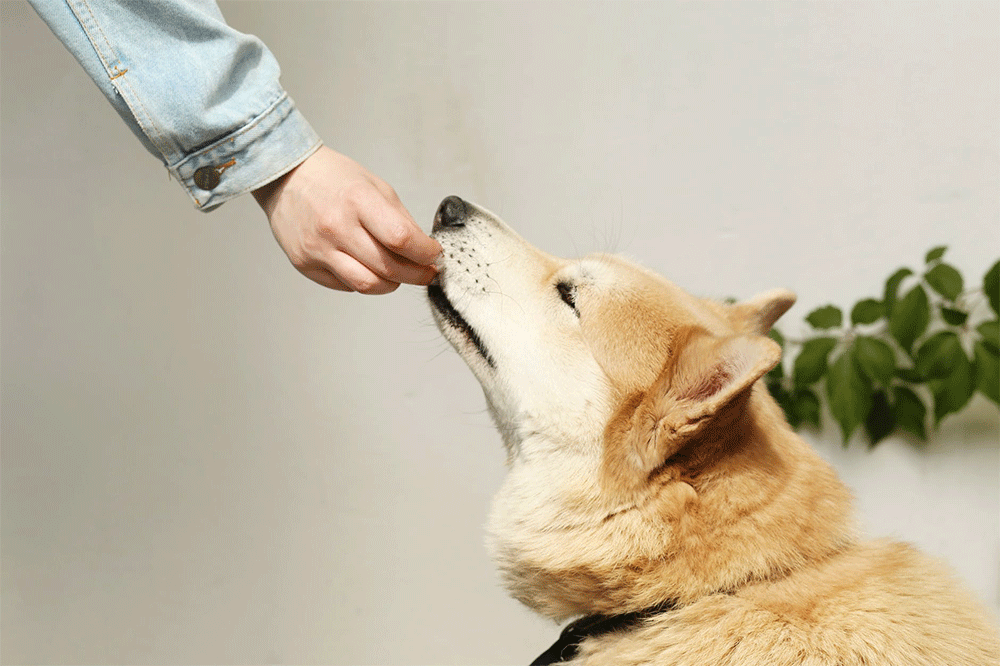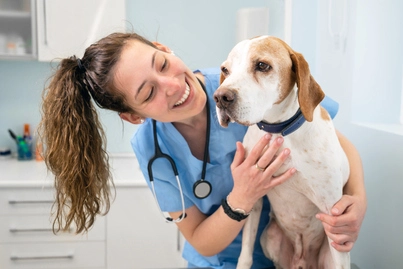Anyone who has ever walked their dog along the beach knows how they love to stick their nose into every nook and cranny and eat anything that even shows the slightest sign of life. This will include crabs, lobsters, and other forms of sea life.
We often treat dogs like humans, giving them the leftovers from our plates when we have finished eating. However, we might have given them something to eat that will not be agreeable with our dog’s delicate digestive system.
In answer to the question posed in this article: yes, dogs can eat crab. However, in much the same as humans, it might cause them some problems if they have a preexisting allergy to shellfish or seafood.
In a normal situation, crab meat is actually a great source of natural protein for your dog, giving them everything that they need for building healthy muscle mass and keeping their digestive system intact. It also contains minerals that will help keep your dog healthy in the long term.

But what are the drawbacks of giving your dog crab or other shellfish? How can a crab-heavy diet affect the functioning of your dog’s internal organs?
If your dog has accidentally ingested shellfish and suffers from allergies, what is the best method of alleviating their symptoms? Can your dog die from crab allergies?
Well, to see the answers to these questions and a lot more, you should keep reading. We have a list of some of the best crab and dog-related advice that you might find on the internet. By the end of this article, you’ll know more or less exactly how much crab food to feed your pooch.
Can You Give Crabs To A Dog?
You might already know that crab and fish are great for the health of the brain and other muscles of the body. This science also applies to dogs, with those that have a fish-heavy diet having much more improved brainpower. This meat is very rich in vitamin B12, which is essential for great organ function.
If your dog has a little bit of crab in its diet, then you will soon start to notice the quality of their skin and hair will drastically improve. It will also improve the quality of their nail and cartilage too. If you feed your dog a high dose of crab, then you might start to notice its coat looking more glossy and improved kidney function.
If your dog has been diagnosed as having a deficit in B12, then introducing crab into its diet can be the best way of boosting its B12 levels. If your dog has any other health problems, then you should check the ingredients of crab meat, as most of the time, it will be a quick restorative.
But giving crab to your dog is not all that simple. To make sure that your crab is safe and healthy for your dog to eat, you have to make sure that you prepare it properly.
Can A Dog Eat Crab Shells?
Put bluntly, dogs should not be fed crab shells in any situation. This is because the shell itself is very hard and can be broken off in the dog’s mouth. The shards of crab shells can then get lodged in the crab’s throat, causing irreparable damage to your dog’s esophagus and digestive tract.
This could also lead to a choking hazard, which is obviously something that you want to avoid during your dog’s dinnertime. This is why you should make an effort to remove every part of the shell from the crab before serving it to your pooch.
If you have a suspicion that your dog is choking on a crab shell or experiencing pain from ingesting it, then you should make sure that you contact your vet immediately.
If Your Dog Has An Allergy, Should You Give It Crabs?
The crab meat is not dangerous to your dog in and of itself. It is only dangerous if your dog has a specific crab meat allergy. Other allergies are usually not exacerbated by ingesting crab meat.
If your dog is allergic to iodine, which crab meat is very rich in, then you can expect some adverse results after ingesting it. Depending on how severe your dog’s reaction to this crab meat is, then you will have to continually monitor your pooch for any extreme reactions, such as difficulty breathing and rashes.
If your dog has allergies to shellfish in general, then we would strongly advise that you not feed it any crab meat whatsoever.
How Can You Tell If Your Dog Has An Allergy To Crabs?
A dog’s anatomy is not that dissimilar from a human’s in that it is susceptible to various types of allergies that manifest themselves in similar symptoms. Humans and dogs can actually react in much the same way to shellfish and crabs.
Here is a list of some of the most common symptoms that can develop after you have eaten shellfish. Remember that these symptoms will all depend on how much of the food they have eaten as well as how severe their allergies are in the first place:
- Running nose – you’ll notice that your dog’s nose is much wetter than normal, with some trails of snot landing on the floor.
- Watering eyes – you’ll notice that your dog’s eyes are a lot more moist than usual.
- Signs of a cold – the overall energy levels of your dog will start to decrease. You’ll notice it sneezing a lot more, as well as not having the energy to run or chase things.
- Swollen face – You’ll notice that your dog’s face is not as defined as usual, with the eyes being a lot smaller.
- Lethargy – in much the same way as the signs of a cold, your dog will be a lot more lackluster in exercise and might not even want to go for a walk.
- Diarrhea – Your dog’s stools will be a lot less solid than they normally would be.
- Vomiting – if your dog is vomiting more than once a day, then this could be a sign that it has developed a bad reaction to the crab or shellfish that it has digested.
These are some of the most common symptoms of allergies to crab or other shellfish. We would recommend that you monitor your dog closely after eating crab for the first time in case any of these signs develop.
If your dog has eaten crab for the first time, then we would definitely recommend that you take it to the vet as soon as possible.
Connect with a verified veterinarian in minutes. No waiting for appointments or office hours. No high fees. Your pet's health made convenient and worry-free.
A lot of these allergies can be brought down quite quickly by making sure that your dog stays hydrated, as well as giving it lots of rest. If your dog develops a swelling in the face and throat, then this could develop into something much more serious, resulting in breathing difficulties and sight issues.
If you are unlucky enough, your dog’s allergy to shellfish could indeed be fatal, so you’ll need to be sure that you act quickly to avoid your dog dying.
Can A Dog Eat A Crab Stick?
Crab sticks are actually a bit of a misnomer in that they are not made from actual crab, but rather surimi meat. Surimi is a kind of cheap, reconstituted crab that contains a lot of additives as well as processed food.
While these ingredients are not overtly harmful to your pet, you can be sure that they’ll have problems digesting it, and it certainly won’t be very healthy. If your dog has a vitamin B12 deficiency, then we would recommend against feeding it crab sticks, as they will not have the nutrient content that you need to keep it healthy.
Crab sticks might also trigger an allergic reaction in your dog, so we would strongly advise against feeding it to them.
Can You Feed Crab Salad To A Dog?
Crab salad is another one that you could easily feed to your dog, but you will have to keep an eye on the preparation. If your definition of a crab salad is simply fresh crab meat (without the shell) with a few greens like spinach and rocket, then feeding it to your pooch should be no problem.
However, if you have a crab salad that contains additional dressing such as mayonnaise, vinegar sauce, onions, and seasonings, then you might have to check whether your dog has any allergies first. Usually, the above ingredients, as long as they are fresh, should only provide nutritional benefits to your pet.
There have been reports that large quantities of onion can be potentially dangerous to dogs, so you might have to watch that you aren’t giving your pet excessive amounts of this vegetable. You’ll notice if your dog has an allergic reaction if their face starts swelling and they have a loss of appetite.
So, in much the same way as feeding your dog ordinary crab meat, you’ll have to be sure that the crab salad is prepared well before giving it to your dog. If your dog has not eaten crab salad before, the chances are that it might develop diarrhea and start vomiting. So make sure you keep watch of your dog!
What To Do If Your Dog Accidentally Ingests Crab
As we all know, having a dog on the beach is great for its health – you can let it loose off the leash and watch it run across wild open spaces, getting plenty of exercise. A beach is a great place for larger dogs as they will have plenty of room to run around and get the much-needed exercise that they wouldn’t be able to outdoors.
However, one of the downsides of this is having a dog that can get his nose stuck in places that it isn’t wanted. You wouldn’t be surprised if your pooch returned with a jellyfish, a seashell, or, you’ve guessed it, the remains of a crab in its mouth. So what happens if you have suspected that your dog has eaten a live crab?
If the crab is still alive in the jaws of your pet, then we would encourage you to get them to drop it. First, coax your dog over in a friendly way. Then, when you get close enough, hold your dog under one arm and use your free hand to yank the crab out of its mouth.
As we have mentioned earlier, if your dog has eaten raw crab meat, then this shouldn’t pose too much of a problem. However, if it still has the shell on, then you might be concerned that there are shards stuck in the poor animal’s throat. If you notice it coughing or hacking it up, then this might mean there is a shell stuck in its throat, and a swift trip to the vet is needed.
If the crab is already dead and in some state of decomposition, then it might contain harmful parasites that could play havoc with your dog’s gut bacteria. This might lead to some discomfort but will not severely impede your dog’s health. Just make sure to keep an eye on it for a few days.
If you try and chase your dog, shouting for them to drop the crab, then the chances are they will run away from you and just try to eat the crab faster.
If your dog has eaten the crab and you can’t get them to hack it up again, then make sure you keep an eye on them for the next few hours. If your dog displays any symptoms such as the ones we’ve listed above, then you should take them to your veterinarian immediately. An upset stomach is usually the first telltale sign of a bad reaction.
If you are far away from a vet or are on holiday, then we would recommend that you call your veterinarian. Explain the situation clearly and ask for their advice on what you should do. If your dog collapses or seems to be experiencing trouble breathing, then you should drive them to the nearest vet ASAP.
Can You Feed Lobster To A Dog?

Lobster is not too dissimilar to crab in that you can feed it to your dog to boost its protein and vitamin B12 levels. Lobsters are very large to eat, and often you might find there are some leftovers at your dinner party.
As long as you remove the shell and your dog does not have any existing allergies to shellfish, then you’ll be able to feed it to them without issue. This is a great way of saving on waste and keeping your dog healthy.
However, we would recommend against feeding your pooch excessive amounts of lobster, as this can negatively imbalance their digestion. You should always try and get most of your dog’s protein from either organic dog food or nutrient-rich chicken.
Lobsters are a great source of omega-3, which is great for the health of your dog’s brain. These oils will make your dog a lot sharper and smarter, which is great if you want to train them. You should try and feed your dog cooked lobster without any additional seasonings or sauces.
If you introduce this food into your dog’s diet, then you can be sure of seeing an increased gloss to their coat and a healthier skin tone. It is also great for their digestion and intestinal tract.
Make sure that you don’t just leave a whole lobster on the plate for your dog to devour. This is a surefire way of introducing hard shells into their diet, which could pose serious choking hazards.
Our Final Say
So if you are looking to introduce seafood into your dog’s diet, you can do so, but with caution. A lot of dogs have allergies, and you have to keep an eye on them after you have fed them crab for the very first time.
One big tip we would recommend is that you de-shell your crab before giving it to your dog, as they will certainly choke on it.

